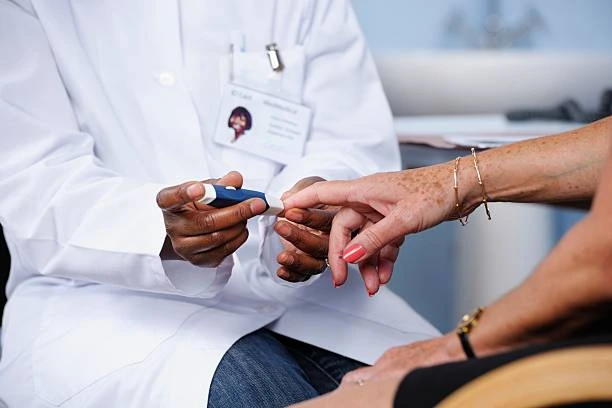Author's details
- Hakim A Abubakre
- BA (Hons) International Business Management, Msc Digital Marketing.
Reviewer's details
- Dr. Khashau Eleburuike
- MBBS (Ilorin) MSc. Global Health Karolinska Institute.
- Resident doctor in family medicine in Northen Sweden.

- Date Published: 2025-06-11
- Date Updated: 2025-06-11
Type 2 Diabetes Mellitus
What Is Type 2 Diabetes?
Type 2 diabetes (commonly called “sugar disease”) happens when there is too much sugar in the blood. This is because:
- The body does not make enough insulin, or
- The body does not use insulin properly.
Insulin is a natural chemical (hormone) made by the body that helps sugar move from the blood into the body’s cells for energy.
When insulin is not working well, sugar stays in the blood. Over time, high blood sugar can damage the eyes, feet, kidneys, heart, and nerves.
Who Is at Risk of Type 2 Diabetes?
You are more likely to get diabetes if you:
- Are over 40 years old (or over 25 for Africans, Asians, or Caribbean people)
- Have a family member with diabetes
- Are overweight or obese
- Don’t exercise or move around much
- Eat too much sugar or oily food
- Had diabetes in pregnancy
- Have high blood pressure
Signs and Symptoms of Type 2 Diabetes
Many people do not feel sick at first. But look out for:
✅ Passing urine often, even at night
✅ Feeling very thirsty
✅ Feeling weak or tired
✅ Losing weight without trying
✅ Cuts or wounds healing slowly
✅ Itching in the private area
✅ Blurry vision
✅ Burning or tingling in hands or feet
✅ Getting infections often
What Causes Type 2 Diabetes?
- The body becomes resistant to insulin – meaning it doesn’t use insulin properly
- The pancreas tries to produce more insulin, but it can’t keep up
- This causes blood sugar to rise and stay high
Being overweight, eating unhealthy foods, and not exercising are big causes. Diabetes can also run in families.
How to Know If You Have Diabetes
Go to a health center or hospital for a blood test.
You may have diabetes if your:
- Fasting blood sugar is above 7.0 mmol/L
- Random blood sugar is above 11.1 mmol/L
Even if you feel okay, sugar in the blood can still damage your body.
How Is Diabetes Treated?
There is no cure for Type 2 diabetes, but it can be managed so you can live a long, healthy life.
🔹 Lifestyle Changes
🟢 Eat healthy
- Half your plate should be vegetables
- A quarter should be protein (fish, chicken, beans)
- A quarter should be starchy foods (millet, cassava, brown rice)
- Avoid sugary and oily food
🟢 Exercise every day
- Walk, sweep, dance, farm, or fetch water for at least 30 minutes
🟢 Drink clean water, not sugary drinks
🟢 Sleep well
🟢 Take care of your feet – check daily for wounds or blisters
🟢 Get regular eye and kidney checks
🔹 Medicine
- Some people need pills like metformin
- Others may need insulin injections
- You may also need medicine for blood pressure or cholesterol
Important: Always take your medicine—even if you feel fine.
Managing Stress and Emotions
Stress makes blood sugar worse. Reduce stress by:
- Praying or meditating
- Talking to family or a health worker
- Sleeping well
- Doing light activities, you enjoy
When to Go to the Clinic
🏥 Go to the health center if:
- You feel very weak or dizzy
- You have wounds on your feet that are not healing
- You lose weight very fast
- You have blurry vision or eye pain
- You vomit or feel confused
- You are tired all the time
- You see blood in stool or have black stool
- You are over 50 and suddenly get constipation or stomach pain
Can Type 2 Diabetes Be Prevented?
Yes! You can reduce your chances by:
✅ Eating less sugar and fat
✅ Eating more vegetables and traditional high-fiber foods
✅ Drinking more clean water
✅ Moving your body every day
✅ Avoiding alcohol and tobacco
✅ Getting tested if you are over 40 or have a family history
Important Messages
❌ Don’t use herbs or spiritual cures without asking your health worker
❌ Don’t stop taking medicine suddenly
❌ Don’t believe in fake cures or scams
✅ Stay in touch with your clinic
✅ You are not alone – with support and good habits, you can live a full life!
- International Diabetes Federation (2021). IDF Diabetes Atlas, 10th Edition.
- World Health Organization (2022). Diabetes Fact Sheet.
- Mayo Clinic (2023). Type 2 Diabetes – Symptoms and Causes.
- Mbanya JC, Motala AA, et al. (2010). Diabetes in Sub-Saharan Africa, The Lancet.
- Hall V, Thomsen RW, et al. (2011). Diabetes in Sub-Saharan Africa, BMJ Open.
